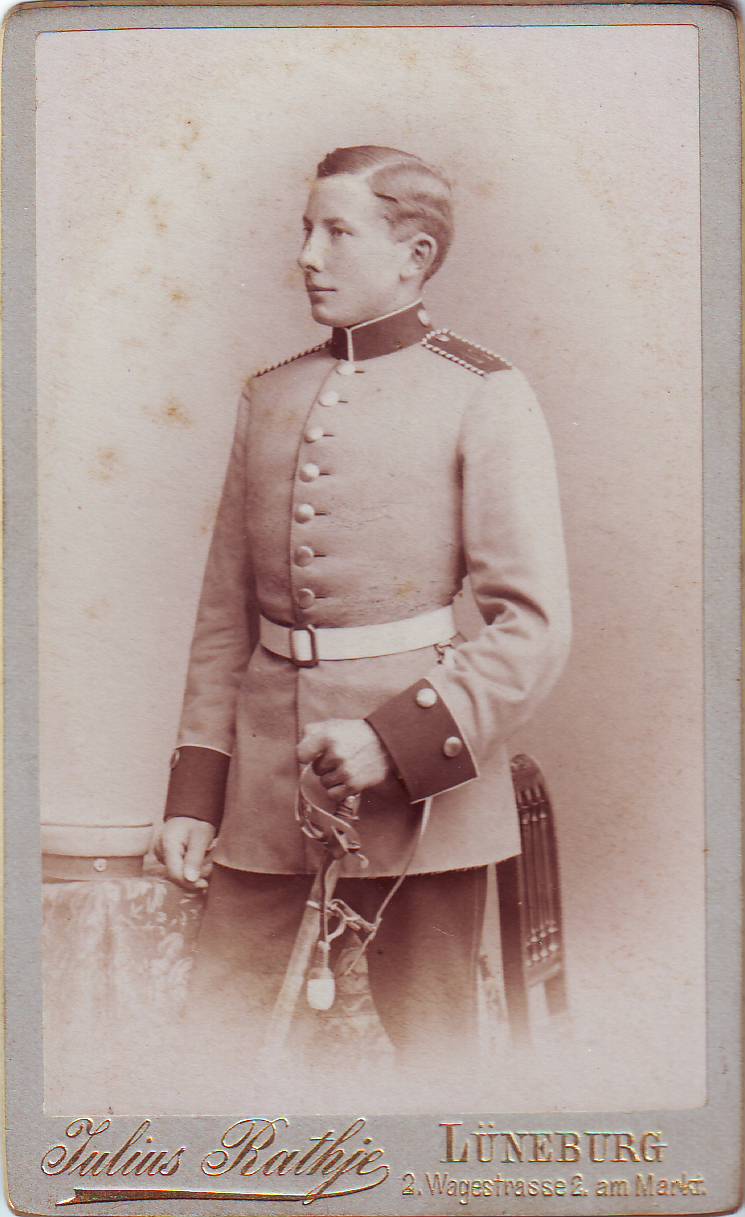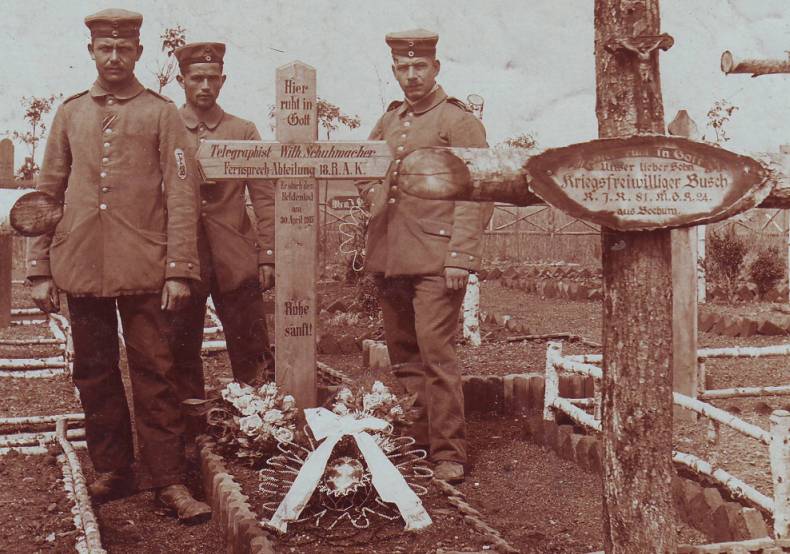-
Posts
3,074 -
Joined
-
Last visited
-
Days Won
5
Content Type
Profiles
Forums
Blogs
Gallery
Events
Store
Posts posted by The Prussian
-
-
Hi Ulsterman!
I can add a photographie of a one-year-volunteer of the regiment.
 0
0 -
Hi Rob!
To get informations about german Flieger Abteilungen and everything about the imperial Luftwaffe, I recommend the forum:
http://www.frontflieger.de/0-navi.html
english language possible.
0 -
And here is an earlier map from oct, 30th, 1918
I hope, I could help you a little bit.
Sources: The german forces in the field november 1918
 0
0 -
Hi Walfisch!
Here is a map from nov, 9th
 0
0 -
put-it-to-the-top-message...
0 -
Hello!
I don?t know the english word for that, we say "Schuldschein" (promissory note???). unverzinslich" = "zinslos" = interest-free)
0 -
Hi Rick!
Thanx for your response!
I?ve heard something about those units, but in the Busche (Geschichte der dt. Infanterie), I can?t find a 24. There were several independent units listed, but not the 24. Maybe the list ain?t complete.
0 -
Yes, that?right, but that doesn?t explain the number 24... Maybe it?a the number of MG companies, if all companies of a corps were counted??? :rolleyes:
0 -
Hello!
I got this photo today. It?s a sad one. But I don?t know the designation at the cross on the right.
I see R.I.R.81 and M.G.K.24
Well, Reserve-Infanterie-Regiment 81. That?s clear. M.G.K.: Maschinengewehrkompanie. Clear.
But the 24?
No regiment had 24 MG companies... and as far as I know, the RIR 81 didn?t have any MG- company.
Any ideas, please?
By the way: The F18 upon the upper arm means "Fernsprech-Abteilung XVIII.Armee-Korps" (In this case XVIII reserve Korps - so the writer signed on the back of this card.)
Thanx a lot in advance!
 0
0 -
Dear Steve!
Well, the system of the train bataillons was nit difficult to you, it WAS difficult...
The train-batallions were disbanded by the outbreak of war. They were distributed to the "Magazin-Fuhrpark-Kolonnen".
Together with the munition-columns (set up by field-artillery) they were formed to "Munitions-Kolonnen und Trains".
In every army corps you find: 2 Munitions-Kolonnen-Abteilungen (4 infantery and 9 artillery columns) ; 1 Foot-artillery Mun.col.Abtl. (8 columns), 2 Train-Abteilungen (12 Feld-Lazerette, 6 Proviant, 6 Fuhrpark (carpark), 2 depots for horses and 2 bakery-columns).
It would be too difficult to explain here, but I recommend you the book:
H. Cron "Deutsches Heer 1914-1918", it?s part V of the edition of Curt Jany "Preu?ische Armee"
In english:
Imperial German Army: 1914-18: Organization, Structure, Orders of Battle: Organisation, Structure, Orders of Battle
0 -
Deruelle: Oh yes, I?ve seen that thread! Wonderful! It?s a very nice collection!
Rick: Which one, please?
0 -
:) Merci... I?m stil looking for photographs, but they are very expensive. In Germany a lot of people are collecting the 95
0 -
-
-
Here are some close-ups:
 0
0 -
Seems like a lot of guys for a peacetime corps staff when one bears in mind the the officer complement was usually seven officers including the corps commander. Perhaps the division and brigade staff officers were on hand. The Chief of Staff was Oberstleutnant Konstantin Schmidt v. Knobelsdorf. Incidentally this photograph was taken at Hermanns Denkmal just to the south of Detmold and in the VII Army Corps District.
Regards
Glenn
Yes, that?s right, but I bought the photo, from an album, which said, the photo was taken by the X.AK. It also said, there was a "Generalstabsreise". Unfortunately I only bought the photo, the text belomgs to the album, that haven?t been in the offer
0 -
No, he wears a Skullhead, because of the 92.th inf.rgt., that belong to the X.AK
0 -
-
No problem, mate... a friend of mine has the Rangliste 05, maybe it helps
0 -
By the way, Chris, do you know books about the Sturmtruppen? Here in Germany I can?t find anything good.
Specially I?m looking for informations, in which battles the SBs were active. Most of the german books only go down on regimental level
0 -
Hi Chris!
Yes, I agree with you, but I think the word "cream" is a wrong one. The "lessons", they gave to other units, were the experiences of a maximum of 1,5 years of combat.
A cream for me, is a bigger unit, that could make a battle won. A bataillon in an army was not able to fight against an enemy division, how ever the strenghth of the enemy was.
What I wanted to say is, the Sturmtruppen were an effective small unit in tactical cases and, of course, in the psychological case. Do you know any battle, won only by the stormtroopers?
In battle, if they were in the frontline, they had a lot of suffers. But they hadn?t an "Ersatz" company. So the new soldiers couldn?t get the experience in a short time. So I don?t think, they were fit for action for 100% each day.
I?d rather be saying that, if you use the word "cream", one better takes this word the old guard-units.
0 -
Hi Chris!
I don?t think, they were the "cream" of the german army. Some people might think so, because in the past years, the name "Sturmtruppen" had become a legendary name, like the french foreign legion...
Have they been trained better? I don?t know. Fact is, they had a better equipment than a regular infantry unit. They didn?t use rifles, they used carabines. The first Sturmtruppen were pioneers.
Major Calsow from the Pi.Btl.15 first formed a experimental troup, depending of 2 pioneer companies with shields and 1 detachment with 20 guns (3,7cm). They first operated at the front of Loretto. They failed.
The rest of those units came to the Armee-Abteilung Gaede.
Now came the well-known Hauptman Rohr (Garde-Sch?tzen-Bataillon). He didn?t use the shields. Rohr trained them in well-done comunication of machine-guns and artillery. As "Sturmbataillon der Armee-Abteilung Gaede", they re-concered the "Hartmannsweiller Kopf" brilliant (dec., 22./23. 1915). Early in 1916 the Sturmbataillon Rohr came to the 5th army.
In 1916 the following Sturmbataillone were founded:
The J?ger-Batallion 3 became the Sturmbataillon 3 (july, 8th. 1916)
The Sturmbataillon Rohr became the number 5 (still a Pioneer unit!!!). The name Sturmbataillon Rohr became official in 1917 (feb.2nd)
and 8 Sturmbataillone, belonging to the Infantry.
Those bataillons came into action in december 1916. They were shared to the differnt armies.
They consist of 2-3 "storm-companies", 1 MG-company and 1 mine-sweeper company and a flame-thrower troup.
Early 1918 existed the Sturmbataillone 1-12 and 14-17. N? 13 and 18 were only companies. The 13 became in march part of the 12th bataillon and the N?18 became the new bataillon 18 in august 1918.
Disbanded were the Btl.9 (may 1918) ; Btl.17 (august 1918) and Btl.12 (october 1918)
Each bataillon of the btls. 1,2,4,6,7,8 and 16 had missed 1-2 companies in 1918.
They also had a special uniform. The 3rd batallion wore the J?ger uniforms, the 5th batallion wore pionier uniforms. The rest wore infantry uniforms. The mine-sweepers of all bataillons wore pionier uniforms with the shoulder straps "M.W."
The artillery detachment of the 5th btl. wore the artillery-uniform with a grenade upon the shoulder straps.The flame-throwers of the 5th btl. wore the uniform of the "Garde-Reserve-Pionier-Regiements" with laces at the collar and a skullhead upon the lower-arm (left).
To come to an end, here again the Sturmbataillone and the date of set-up)
1916: N? 1 ; N?2 ; N?3 (J?ger) ; N?4 ; N?5 (Rohr) ; N?6 (bavarian) ; N?7 ; N?8 ; N?9 ; N?10 ; N?11 ; N?12 ; N?15 (bavarian) ; N?16
1917: N?14 ; N?17
1918: N?18 ;
If we have one bataillon for one army, I don?t think they were the cream og the german army. What could they do in any strategic questions? Nothing.
They were brilliant in tactical solutions on regimental, maybe on divisional level.
Nevertheless I think, the were the forefathers of modern small, tactical units, who are used more and more in our times.
0 -
Hello Gentlemen!
Does anyone have an idea to ID this men from the X.AK?
Probably it shows the General staff from 1905
The Photo is dated: 15.6.-29.6.1905
Thanx a lot in advance
 0
0 -
Well, I haven?t beemn in school 1943 (born 67), but I think, I?m as weird as you, mate...

The proper S?tterlin ain?t no problem, the problems start, if they wrote it fast. In Germany we say, "he writes like a doctor writing your prescriptions" That means, no one else could read it, but himself...
0





Dragoon Regiment 13
in Germany: Imperial: Rick (Research) Lundstrom Forum for Documentation and Photographs
Posted
Hi Sonya!
No, unfortunately I don?t know the name. :(